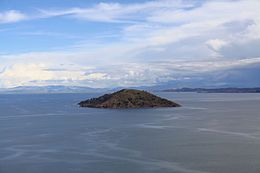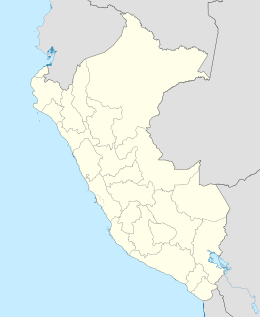geo.wikisort.org - Island
Taquile (Spanish: Isla de Taquile, pronounced [ˈizla ðe taˈkile]; Quechua: Intika) is an island on the Peruvian side of Lake Titicaca 45 km offshore from the city of Puno. About 2,200 people live on the island, which is 5.5 by 1.6 kilometres (3.4 by 1.0 mile) in size (maximum measurements), with an area of 5.72 km2 (2.21 sq mi). The highest point of the island is 4,050 metres (13,287 feet) above sea level and the main village is at 3,950 metres (12,959 feet). The inhabitants, known as Taquileños, speak Puno Quechua.
 Taquile from Amantaní island | |
 Taquile | |
| Geography | |
|---|---|
| Location | Lake Titicaca |
| Area | 5.72 km2 (2.21 sq mi) |
| Highest point | 4.050 |
| Administration | |
Peru | |
| Demographics | |
| Demonym | Taquileño |
| Population | about 2200 |
| Ethnic groups | Quechua |
In 2005, "Taquile and Its Textile Art" were honored by being proclaimed "Masterpieces of the Oral and Intangible Heritage of Humanity" by UNESCO.
Textiles
Taquileños are known for their fine handwoven textiles and clothing, which are regarded as among the highest-quality handicrafts in Peru. Knitting is exclusively performed by males, beginning in early boyhood. Women spin wool and use vegetables and minerals to dye the wool to be used by the community. Women are also the weavers of the Chumpis, the wide belts with woven designs worn by everyone in the community of Taquile.
Tourism

Taquileans are known for having created an innovative, community-controlled sustainable tourism model, offering home stays, transportation, lodging for groups, cultural activities, local guides and restaurants. Ever since tourism started coming to Taquile in the 1970s, the Taquileans slowly lost control over the mass day-tourism operated by non-Taquileans. Taquile community have their own Travel Agency Munay Taquile has been established to regain local control over tourism.
Society and economy
Taquileños run their society based on community collectivism and on the Inca moral code ama sua, ama llulla, ama qhilla, (Quechua for "do not steal, do not lie, do not be lazy"). The island is divided into six sectors or suyus for crop rotation purposes. The economy is based on fishing, terraced farming horticulture based on potato cultivation and tourist-generated income from the approximately 40,000 tourists who visit each year. Taquile's families own rams, sheep, cows, chickens and sometimes guinea pigs.
Cuisine
Taquile offers a wide range of typical dishes. Breakfast consists of two pancakes with sugar or bread with eggs, with a cup of tea made from either Muña or Coca. For lunch, dishes are a vegetable soup, fish with rice and a tomato and onion salad. For dinner, the Taquilean people serve vegetable soup with bread.
Religion
The majority of the inhabitants of Taquile are Catholic. They adapted this religion, harmonizing Andean religion with the syncretic Christian culture. The mother earth (Pachamama), the principal Andean deity, directly controls harvesting and fertility; the island is home to four Apus, Andean mountaintop deities. People make several offerings to these deities each year, and they offer three coca leaves prior to each activity or trip. God is present throughout the year in the festivities. The two Catholic churches are in Centre and Huayllano; a Seventh-day Adventist church is located in Huayrapata.
Infrastructure
Taquile has a radio station and is equipped with generators. Islanders have elected to use solar panels to generate energy.
Flora
Flowers and trees on the Island include Kolle, the tree used to roof the houses and for firewood, the Cantuta flower (the national flower of Peru), the Chukjo (used as detergent) and Muña, used as natural medicines. Coca leaves are not cultivated in Taquile.
Gallery
- A festival on Taquile
- The annual Fiesta de Santiago
- Taquile, Puno, Perú. Mujer hilando
- Taquile, Peru: Lake Titicaca Children of Taquile
- The Arch leading to the main square of the island
- Banks of the lake Titicaca
See also
- Iperu, tourist information and assistance
- Tourism in Peru
Bibliography
- Kusikiy A Child from Taquile, Peru, 2010 ISBN 978-0-9844079-8-9
- Elayne Zorn, 2004. Weaving a Future: Tourism, Cloth and Culture on an Andean Island, Iowa City: University of Iowa Press. ISBN 0-87745-916-9
External links
На других языках
[de] Taquile
Taquile (Spanisch) oder Intika (Quechua) ist eine Insel im peruanischen Teil des Titicaca-Sees, 45 km von der Stadt Puno entfernt. Die Insel ist etwa 5,5 km lang und bis zu 1,6 km breit. Der höchste Punkt liegt bei 4.050 m Höhe über dem Meeresspiegel, der größte Ort bei 3.950 m (zum Vergleich die Wasseroberfläche des Titicaca-Sees: 3.810 m).- [en] Taquile Island
[es] Taquile
La isla de Taquile (Intika en quechua), en el lago Titicaca, pertenece al distrito de Amantaní, Puno, Perú. La isla está situada a 45 km de Amantani la capital regional. Cuenta con una población de unos 2200 habitantes. La villa principal se encuentra a 3.950 msnm y el punto más alto de la isla llega a los 4.050 msnm. La isla pertenece al dominio lingüístico del idioma quechua y el gentilicio de sus habitantes es taquileño/a.[fr] Taquile
Taquile est une île péruvienne sur le lac Titicaca. Située à 45 kilomètres à l’est de la ville de Puno, l'île est vallonnée et mesure 5,5 sur 1,6 km dans sa longueur maximale, avec une superficie de 5,72 km2. Taquile compte environ 2 200 habitants. Elle servit de prison durant la colonisation espagnole et au XXe siècle. En 1970, l’île devint la propriété des personnes qui y vivaient jusque-là.[ru] Такиле
Такиле (исп. Taquile) — остров на озере Титикака, входящий в состав Перу и расположенный в 45 километрах от прибрежного города Пуно. На острове длиной 5,5 и шириной 1,6 километра проживает, по разным оценкам, от 1700 до 2500 человек. Самая высокая точка острова поднимается на 4050 метров над уровнем моря, главная деревня острова находится на высоте 3950 метров над уровнем моря. Жители острова, известные как такильцы (исп. Taquileños), говорят на языке кечуа.Другой контент может иметь иную лицензию. Перед использованием материалов сайта WikiSort.org внимательно изучите правила лицензирования конкретных элементов наполнения сайта.
WikiSort.org - проект по пересортировке и дополнению контента Википедии





